Tektronix 547
Update: 8/28/18
The method described below did NOT hold up over time sadly, so what is written below is purely for interest.
Update: 1/28/16
I dried and vacuum sealed the HV transformers in beeswax at the end of August. Since then we have have 4 months of high humidity before the onset of winter. I have just run the two scopes for over 48 hours continuously with no HV issues at all. Previously they would run maybe 4 hours before the HV collapsed. To recap, this issue is well know in Tek circles and came about with the change of sealant from beeswax to epoxy and I surmised that it was due to the tendency of epoxy to absorb moisture 0ver time. Having baked one transformer out previously, it then worked but as expected, failed again after a few months in my damp basement. So, I decided to bake the transformers out under vacuum in molten beeswax, then gently restore the atmosphere and let them cool. It looks as though this solution does work.
This post is part of my effort to complete and clean up loose ends as I disperse my collection.
I have two of these superb instruments, the final bow of the valve era for scopes and what a bow! Sadly though, that bow was assisted by a mostly transistor Y system. In mitigation of this heinous offence, the magical X system was mainly valved and could have been implemented using valves alone. I am not going to provide a full-blown discussion of the 547 scope at this juncture, rather to focus (pun intended) on a problem specific to the 546/547 models, failure of the HV system due to the substitution of epoxy for the traditional beeswax HV transformer seal.
The problem is typically that the scope will work when turned on and then, after some time, the HV collapses. If using it, this is first evidenced by the traces lengthening as the CRT sensitivity increases with the falling HV, though the traces actually brighten, at least initially. I first experienced it working through the lengthy calibration procedure. I discussed the issue with Stan Griffiths several years ago, he told me that it was thought to be dielectric absorption due to the epoxy. Hmm I thought, I wonder? So I baked a transformer out and it worked properly for a while, however it soon failed again; I am not the only one to have done/discovered this. My thoughts are: That the issue is not an intrinsic epoxy dielectric issue, rather power lost to heating of any moisture present in the epoxy; epoxy does absorb moisture (by diffusion) so what if I could dry it out and then seal the result? Knowing that beeswax is basically moisture impermeable, I decided to bake a transformer out in molten beeswax, evacuate it and slowly allow the pressure to return to ambient thereby sealing the newly dried transformer. I described my thoughts to Bruce Baur and Stan Griffiths by email back in May of 2014 but it has taken a while to get a “rountoit”.
Accordingly I bought a vacuum pot and pump for the quite reasonable price of $150. The pot is aluminium with a thick lexan top. The instructions provided with it insist that one MUST NOT continue to pump once the gauge has dropped to 29 in Hg otherwise there is a danger that the pot will implode! With respect, this is bunk. In round numbers, one atmosphere is 15 lbf/Sq in corresponding to 30 in Hg. Pumping down to 29 in Hg results in an external pressure of approximately 14.5 lbf/Sq in (or “squinch” as one of my excellent teachers used to say). Pumping down the final inch results in the effective external pressure rising to 15lbf/Sq in, that is to say roughly an increase of 3%. If this increase will cause the pot to collapse then it should not be on sale for this purpose. In fact for external pressure, vessels are customarily designed with a safety factor of 3*. That means it should be impossible to collapse the pot when pumping down from atmospheric pressure.
(*For external pressure, the design safety factor on yield has to be greater than that used for internal pressure because the failure mode due to compression results in failure by buckling which unlike direct tensile failure, is very difficult to predict accurately. Geometric factors such as dents are critical.)
I used USP beeswax that I bought from Amazon, for a fair price if there is any such thing anymore.
Here is the HV transformer and rectifier assembly partly removed:
Transformer removed showing heater power loops:
First, I put two transformers in a can with beeswax powder in the oven for 24 hours at 170 °F. (The melt temp is around 140 °F and the lowest setting for my oven is 170 °F) There was a nice smell of honey! To ensure that the wax remained molten as I evacuated the pot and returned the atmosphere, I needed to safely heat the vacuum pot. I heated a 5lb weight in a small oven at 220 °F that I then placed into the pot just before placing the transformers with their wax. The vacuum pot was placed into a large saucepan with water that I gently heated until I could just see wisps of steam escaping up the sides. (The weight also served to keep the vacuum pot firmly down in the saucepan.) I then transferred the transformers into the pot and evacuated it. I did go to far though because the wax started to boil below about 25 in Hg of vacuum. At that point, I turned the heat under the pan arrangement off and allowed the atmosphere to return by leakage, having turned the pump off. This took about 30 min and at the end, the wax remained molten as I intended. I then removed the top and hung the transformers over the tin to drip (having soldered on copper hook wires before starting the process).
If I do this again (I have a third transformer) the only change I would make to the procedure is to hold the transformer under vacuum carefully at 20 to 25 in Hg for some number of hours (with the wax molten of course) before letting it leak back to atmospheric pressure.
Ready to evacuate:
Evacuated:
Dripping:
By the way, my mother always looked in the garage if anything was missing from the kitchen!
I ran the first unit for 10 hours straight and it did well. In particular, the oscillator screen grid voltage was a few tenths lower than when I turned it on (not powered it up, what a pretentious BS way of saying it). The HV had stayed dead stable; however stability of the SG voltage is the best indicator, it will rise if the oscillator load increases, topping out at 152V or so. Note the real meter (on the 3000V scale) on the HV test point!
The oscillator tube is run quite hard so you should check the transconductance. The few I have are around 25% down. The other thing is the B+ feed to the oscillator is via a 270Ω carbon resistor. If run hot, these develop internal cracks and that can be a reason for failure. The resistor in my unit measured 434Ω cold, most likely higher when hot so I replaced it with a wirewound resistor.
The question now is whether this fix will stand the test of time. I keep this equipment in an unconditioned basement and there are 10 weeks or so of high humidity left so if it works in the winter, that will be a solid sign that all is well.
8/30/15 Update: I have three of these transformer units, all three were failing in the way described and all three now hold up over a 12 hour period. I will test again at the onset of winter once the units have been exposed to what is left of the summer humidity.
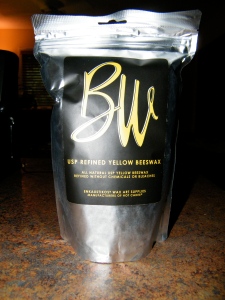
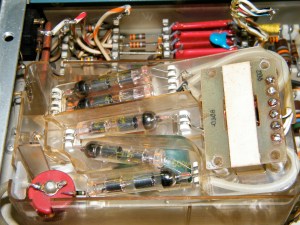
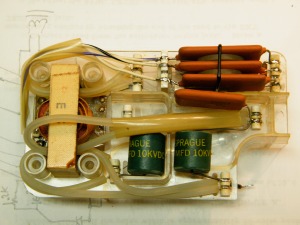
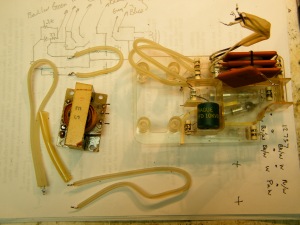
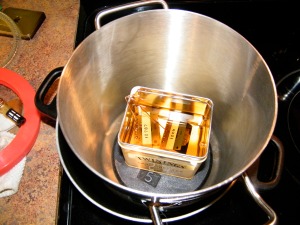
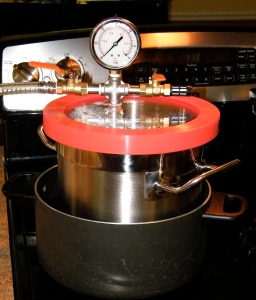
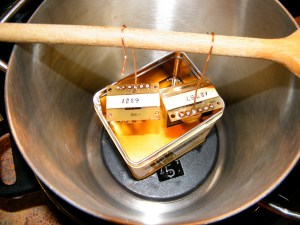
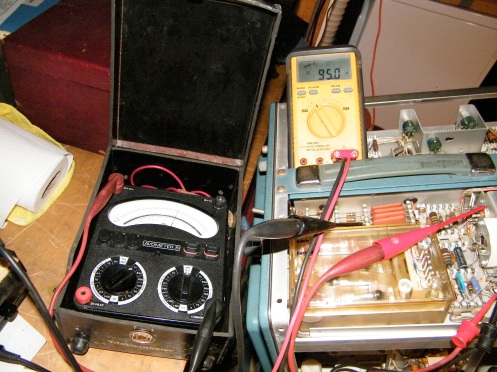
I have the exact same problem with a 453. Since I saw several “valve”s in your writeup, I presume you’re in the UK and not able to throw my transformer in the pot at the next go-round. But Bruce is getting hardware together to try it here in Oregon.
Actually, I am an expat Brit in NC. I have third unit in the oven right now. I will be happy to do yours if you wish for return postage. Of course, we won’t know for a while if this really is a fix.
I sometimes use “valve” out of some kind of “rebel without a cause” cussedness!
Richard, thanks for the great post and good to see you are on the run and could not wait for us. I have been in contact with the Tek transformer guru and he is trying to get a hold of his former contacts to find the recipe or possible off the shelf bees wax concoction. That has been taking some time. It was not pure bees wax, but that was the major portion of the mixture.
Do you think the bees wax was bubbling under vacuum or was it air or moisture in the winding bubbling up? It may be the case, as the pressure goes down, the boiling point of many materials goes down. You may have it the boiling point of bees wax.
Great work, keep us posted,
Bruce
Hi Bruce.
Yes, I need to get on with finishing things up. Yet another interest is hoving into view, other than the piano which remains my primary focus, and that is steam loco’s. This is a life interest, I actually participated in the restoration of a 4-6-2 loco as a young man. I am considering a gauge 1 live steam set up in the basement!!!!
It was definitely boiling, a full rolling boil. If you put a glass of water under vacuum, once the pressure falls past 29 in Hg, it will boil. Beeswax melts around 140 and I had it closer to 170 (well under smoke temp), lots of latent heat. I will be repeating this today with my 3rd transformer and will take care not to go below 25 in Hg.
On the beeswax, I am confident about using it in a purified state from a dielectric point of view. From a mechanical properties POV, maybe to increase coating thickness. What I was left with had no substantial thickness, unlike the traditional transformers where the wax is visible. So, my seal coating is very thin which is fine for me but maybe not so good for a production environment. That is what I surmise any additional ingredients may be for, to improve coating thickness. However, what you don’t want is increased surface tension for that will inhibit the penetration, if there is any, probably not on reflection.
Richard
Richard, you keep life interesting with all these hobbies, watches, piano, tube electronics, steam, and probably more. My brother is into speeders and I have ridden the rails with him several times. You get to see both sides of the tracks at the same time. He has 4 of them.
I guess I never thought of it, but almost any liquid will boil at the proper temperature and pressure. So I wonder if the bees wax vapor is then condensing inside the vacuum pump when it finds a cooler place at higher pressure?
Hi Bruce.
I have now tested the second unit, for an 8 hour then a 12 hour run, the test and screen voltages were reMained solid. I will test the third unit by the end of the weekend. It is essential that the shunt and oscillator tubes are good and that the B+ feed resistor is good also. Otherwise, given the real moisture impermeability of beeswax, I think this may do the trick. Time of course will tell, especially a full summer (2016) in my basement!
Richard, very nice job! You baked out a transformer and it recovered, but after some time it died again. How long did it take for that to happen? I was just hoping that we don’t have to wait a whole year to prove out this method. Thanks for the great work.
Hi Bruce.
In truth I don’t know. I remember baking it in May and then turned it on some months later to find that it was failing again.
My feeling is that the wax seal is as impervious as possible so if it works, it works. I can always be wrong though.
We are having a cool summer but the humidity will remain high for some weeks yet, so if it works at the onset of winter, I think we can be confident in the efficacy of the process.
that 547 HV box seems to be the same thing then in the big brother 556
and also driven by a 6GF5?
556 have also oftenly this problem, the source is a over heating of the transformer inside of this plastic box. It is not original but it may help to put a little Fan on the box, so the transformer will not be fried there inside.
many greetings from germany
Martin
Hi Martin
The problem with the 546/547 is definitely due to the epoxy and moisture. Stan Griffiths told me that Tek scopes did not have this problem until they changed to epoxy impregnation for the transformer. As say in my narrative, epoxy is moisture permeable and I have enough bake out experience of these transformers that were not working properly to pretty much establish that moisture is the problem. So the question became, how to prevent re-adsorption of moisture after baking and vacuum sealing with beeswax seemed to me to the obvious method to test, given that beeswax is absolutely not moisture permeable and has a solid record for the sealing of such transformers. The two scopes that have transformers that I baked and oversealed with beeswax continue to function properly, I recently ran them both for 24 hours straight with no problems.
I don’t know if the 556 transformer is sealed with epoxy or not. The 547 uses a 6AU5 with a plate rating of 10W and a Gm of 5.6 mA/V. You say that the 556 uses a 6GF5 and that has a plate rating of 17.5W and a Gm of 8.5 mA/V so it looks to me as though the 556 oscillator is more powerful which is consistent with more heat of course. So, the 556 may have both issues or just heat related failure.
Best wishes,
Richard
Richard,
I have just come for a visit, as I do periodically, and found that you are moving on to new things. I just wanted to say thank you for the wonderful write-ups of your Tek journey. Your writings have inspired me and I now have a few more Tek scopes, and other beautiful things, than I have a real use for. Indeed, I just secured myself a Tek 556 today, (I’ll have to drive down the M11 to pick it up) which was what prompted today’s visit to your site.
I have an unexpected mix of feelings upon finding that you won’t be restoring and writing about Tek kit for ever and ever, seeing the Avo 8 and reading that you are British too.
I wish you very well and, once again, thanks.
Richard B
Hmm… I think Chuck from Tekscopes said that beeswax absorbs water at the same rate as epoxy, except it also quickly releases it by getting hot. If this is true, wouldn’t the wax-coated transformer get the moisture after a while?
People say stuff all the time, often without any evidence. If you have read my notes thoroughly, you will get where I am coming from and that I haven’t said that I know for sure of that I have done will work long-term. I do repeat that this problem with the HV transformer did not appear until Tek changed from beeswax to epoxy. Enough said.
a good absorbing of water is to put the equipment and a spoon of salt in a vacuum box for a time of some hours.
I made a small homebrew vacuum apparat to dry something like that, it works very well.
Now I have the typical problem of all who enjoy to collect Classic Tek scopes, the home is full with them, so I have to take care for a place before I get the next old Tek 🙂
The last restoration was a little 214, so I have only to look for a 211 to complete the µTek family the other 4 types are here.
greetings
Martin
I rewound my 453 transformer. I used the “layer winding with retrace” technique instead of “universal”, which made building a winder very easy. It’s been at least a year now, and the scope is still working fine. I wrote up my experience on the “tekscopes” Yahoo group.
Hi Dave.
Thanks for your comment, You may be able to help the next correspondent, John Adams?
Hello Richard,
good work you have done on your Tek 547 scope, i have the same thing over here witch i have used for quite some time now.
i experienced the same trouble with the EHT around T801 now, and so i know that my transformer is dying.
i really want to ask you, is there somewhere on the net a rewinding guide? or can you help me with an address where i can let it rewound?
i hope you can help me.
John Adams
The Netherlands
Hi John.
Check out the previous comment from Dave Wise. Maybe corresponding with him will help. I don’t know of anybody who would undertake this.
Richard
If you want to try rewinding it, the spec for the 547 transformer is available. Try asking at VintageTek.org . I have a paper copy somewhere if you’re at wit’s end. It’s built just like the 453, just different turns and wire sizes, so my technique should work. Even a simple one like this is stressful, though. Having done one now, I’m not eager to do another. If I wasn’t in a hurry, I’d wait for Chuck Harris, or try Bruce’s wax vacuum-sealing trick.
Thanks for the input Dave. Actually, the beeswax method came from me.
Richard
Wow, fantastic information Richard! So glad to see such a vibrant community of vintage Tek lovers. I recently acquired a 556 after years of looking for one at a reasonable price. As with most, it operates great for 20-40 minutes before the HV collapses. Knowing that you vacuum impregnated your transformers with beeswax back in 2015, are there any updates to report? Are they still functioning properly for long runs after 3 years passing? I’m interested in picking up a vacuum chamber to replicate your procedure, but it would be good to know if you’ve learned anything in the meantime.
Best regards,
Darren
Hi Darren.
Your have asked a good question. I’ve mostly moved on from this hobby though I still have all the gear and would like to see it go! The answer is no, the “method” does not hold up over time sadly. I need to post an update.